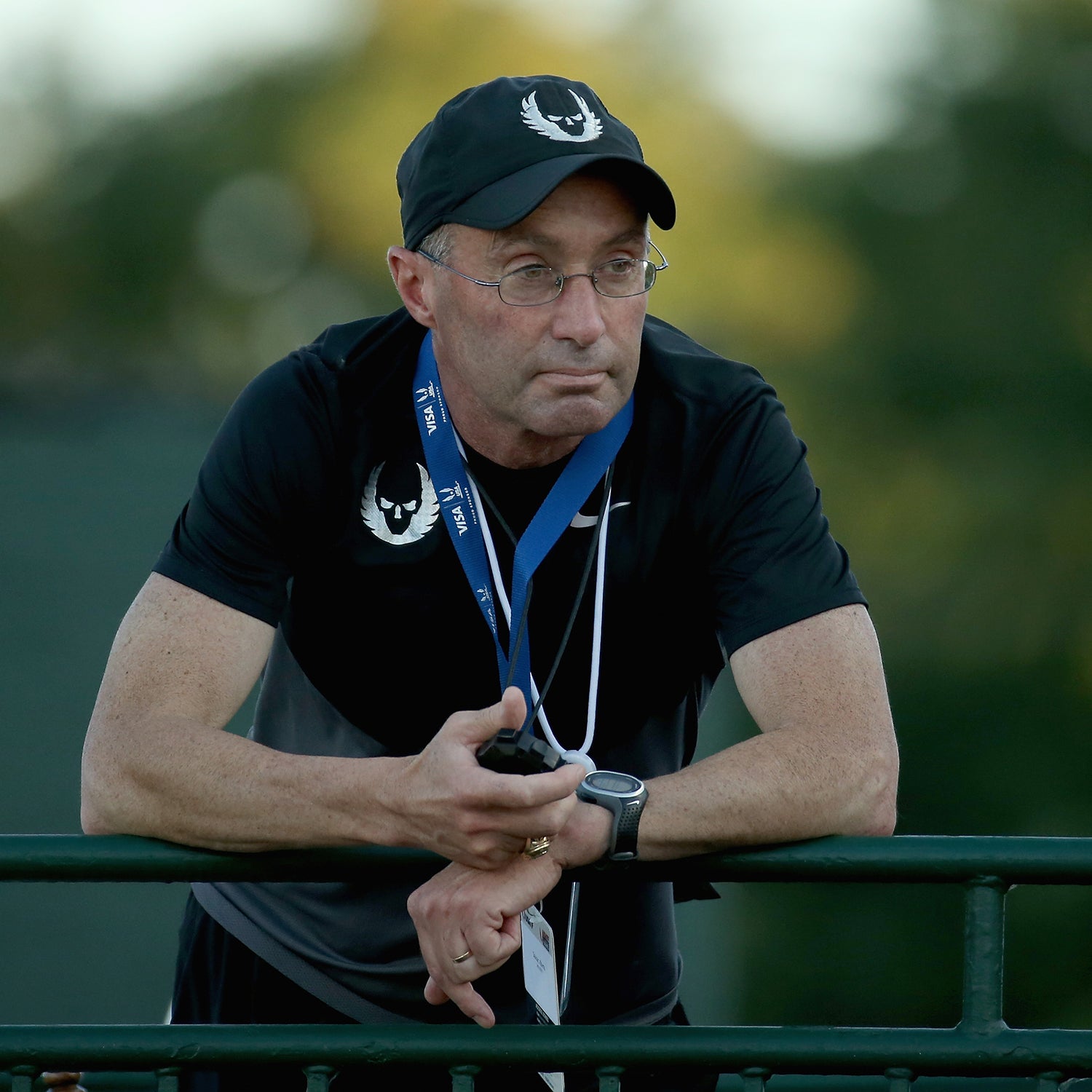On September 19, the Oregonian reported that John Capriotti, the vice president of marketing for Nike’s track and field department, had left the company. Even though Capriotti will continue to work with Nike as a consultant, his stepping down qualified as major news in the pro running world. After all, for more than two decades “Cap” had managed Nike’s vast budget for the sport, deciding which athletes and teams the company would sponsor. The headline in the Oregonian didn’t hold back: Capriotti was “Nike’s track and field overlord.” But Capriotti has also been called other things over the years. As Mario Fraioli phrased it in his weekly running newsletter, The Morning Shakeout, the former marketing executive is “arguably the sport’s biggest benefactor, as well as perhaps its biggest asshole.”
How does one earn such an impressive distinction? Win at All Costs, a new book by journalist Matt Hart on the rise and fall of the Nike Oregon Project (NOP), offers some clues. There was the famous incident at the 2015 USATF Championships where, according to a police report filed at the time, Capriotti repeatedly threatened to kill Brooks coach Danny Mackey. In Hart’s book, Mackey claims that the assault was in retaliation for the fact that Mackey (who is a former Nike employee) was one of the whistleblowers in the USADA investigation of the NOP. The elite running team was ultimately disbanded last year after its head coach, Alberto Salazar, received a four-year suspension for doping violations.

Another whistleblower in the case was former NOP runner Kara Goucher. Last year, in a separate scandal, Goucher revealed that Nike unexpectedly stopped paying her salary when she became pregnant in 2010. Hart reports that Capriotti took Goucher out for a celebratory dinner when she became pregnant and assured Salazar, her coach, that Nike wouldn’t freeze her contract as long as she “stayed relevant” by making media appearances. Goucher complied, but Nike stopped paying her anyway. Capriotti subsequently denied ever making any such promise. Hence: asshole.
While these episodes are chronicled in detail in Win at All Costs, the book sets itself a larger target. In May 2017, Hart’s front-page article in The New York Times reported on the way NOP athletes, at Salazar’s insistence, had been administered potentially illegal infusions of the amino acid L-carnitine by a dubious Houston endocrinologist named Dr. Jeffrey Brown. The infusions, Hart writes in the Times story, were consistent with “a culture of coercion, secrecy and possible medical malpractice in the Oregon Project.” For Hart, the buck doesn’t stop there. Win at All Costs is, in effect, a 350-page polemic which argues that the NOP’s transgressions are consistent with a ruthless Nike ethos where the ends always justify the means.
Hart does his best to establish that brashness was endemic to the company from the beginning, starting with its co-founder, Bill Bowerman. The former Oregon University track coach, we are told, “was just as likely to recite a biblical verse as he was to take his penis out and urinate on his young athletes in the showers, or brand them with a hot key in the sauna as a perverse test of their pain tolerance.” Among Bowerman’s victims was an enterprising Oregon runner named Phil Knight, with whom he would found Nike (or “Blue Ribbon Sports” as it was initially called) in 1964. Over the course of several decades, Knight would shepherd his company to global supremacy with a series of aggressive marketing initiatives and savvy pro athlete sponsorship deals. Here, too, a certain irreverence (not to say assholishness) was part of the strategy. Everyone knows about Michael Jordan and Bo Jackson, but Win at All Costs reminds us that the first official Nike-sponsored athlete, in 1972, was the Romanian tennis ace and noted superjerk Ilie “Nasty” Năstase. Hart also mentions that in the early days Knight had a business manifesto composed of “Nike Principles,” which asserted, among other things: “Perfect results count—not perfect process. Break the rules; fight the law.”
Capriotti makes an early appearance in Win at All Costs, and looms throughout the narrative as the ominous moneyman. The future marketing maestro was hired by Nike in 1992 after leaving a job as head track and field coach at Kansas State University following a scandal in which he admitted to making illegal payments to college athletes. Rather than a red flag, Hart implies that Nike regarded Capriotti’s flouting of NCAA rules as proof of his go-getter mentality. As Hart writes, “Nike was a place where raw ambition was celebrated and Capriotti found himself at home among even the most truculent executives.”
Enter Salazar, the man who was the world’s preeminent marathoner in the early ‘80s, only to burn out by his mid-twenties and eventually resurface as his sport’s shrewdest coach. Much of Win at All Costs is dedicated to deflating this particular aspect of Salazar’s image, thanks to new testimony from ex-NOPers like Goucher and her husband Adam, as well Steve Magness, the former coach turned USADA whistleblower. Rather than a genius innovator, Salazar comes off as someone eager to spend Nike cash on the latest performance-enhancing gadgetry in order to throw whatever he can at his athletes and see what sticks. For many years, things did not stick. The NOP was founded in 2001, but it was only about a decade later that the team really started to have significant success on the global stage—most conspicuously at the 2012 London Olympics, where NOP athletes Mo Farah and Galen Rupp went one-two in the men’s 10,000-meters.
However, it must be said that Win at All Costs does not include any earth-shattering revelations which prove that the aforementioned successes are the result of illegal methods. There are morsels that running fans will savor; Salazar, hilariously, is apparently addicted to Letsrun.com. The book also includes new sordid details about his treatment of Goucher that are unlikely to help resuscitate his image. Nonetheless, Win at All Costs often feels less like an exposé than an attempt to fuse previously published reporting into a macro-narrative about how there’s something rotten in the state of Beaverton. Seemingly every scandal in Nike’s history is exhumed to make the case: from prominent examples of Nike-sponsored dopers like Lance Armstrong and Marion Jones, to the child labor/sweatshop fiascos of the ‘90s and 2000s, to more recent allegations of sexual harassment at Nike’s HQ.
One can certainly argue that some of these tangential cases are relevant to what happened with the NOP; for example, a coach who has now been accused of abusing several of his former female athletes might have been emboldened by a sexist corporate environment. But when it comes to doping, Hart occasionally overstates the extent to which a “win-at-all-costs” mentality reflects a deep-seated malevolence, as opposed to a brand image that cares more about having the best athletes wear their product than being a beacon for “clean sport.” (When Hart visits the company’s corporate HQ, you half expect a Swoosh-laden Lucifer to be making rounds on the Hollister Trail.)
In some ways, the most interesting aspect of the whole NOP saga is the question of what constitutes cheating in the era of marginal gains. Salazar, as Win at All Costs reminds us, had no compunction about gaming therapeutic-use-exemption rules to get his runners on medication for the specific purpose of performance enhancement. He likewise instructed his athletes to receive L-carnitine infusions after he witnessed firsthand how an undisclosed dosage of the supplement transformed Magness from a decent post-collegiate runner into someone who could suddenly rip tempos with Farah and Rupp. (Nothing like old-fashioned hard work!) For many coaches and athletes, such practices are surely on the wrong side of what Salazar himself once described as “the line between acceptable performance enhancement and cheating.”
And yet, they could still ultimately be deemed legal. In November, the Court of Arbitration for Sport is scheduled to hear Salazar’s case as he attempts to overturn his suspension. Nike is funding his appeal. In that sense, the company might be making Hart’s argument for him.


